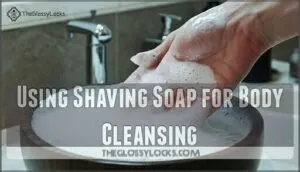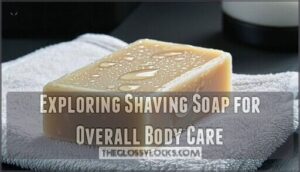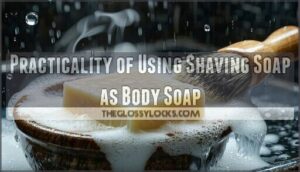This site is supported by our readers. We may earn a commission, at no cost to you, if you purchase through links.

Shaving soap works differently than regular soap – it’s formulated to create rich, protective lather rather than just cleanse.
This means you’ll get decent cleaning power, though it won’t strip oils as aggressively as traditional body soap.
The glycerin-rich formula actually moisturizes while washing, making it gentler on sensitive skin.
Just work up a good lather in your hands or with a washcloth.
However, the unique ingredients and pH levels mean some surprising effects on your skin’s health and hydration levels.
Table Of Contents
- Key Takeaways
- Can You Wash With Shaving Soap?
- Using Shaving Soap for Body Cleansing
- Impact of Shaving Soap on Skin Health
- Shaving Soap Vs. Regular Soap for Body Care
- Shaving Soap as a Body Wash Alternative
- Skin Benefits of Using Shaving Soap
- Exploring Shaving Soap for Overall Body Care
- Practicality of Using Shaving Soap as Body Soap
- Incorporating Shaving Soap Into Your Body Care Routine
- Frequently Asked Questions (FAQs)
- Can you use shaving soap to wash your body?
- Is shaving soap good for the skin?
- Does shaving cream clean your skin?
- What makes shave soap different?
- Can I use shaving soap as regular soap?
- Can you use shaving soap as a body wash?
- Is shaving soap better than regular soap?
- How long does shaving soap last as body wash?
- Is shaving soap suitable for use on children?
- How does shaving soap affect tattoos or body art?
- Conclusion
Key Takeaways
- You can safely wash your entire body with shaving soap, but it won’t clean as effectively as regular soap since it’s designed for lathering and skin protection rather than deep cleansing.
- Shaving soap’s glycerin-rich formula moisturizes better than traditional soap, making it gentler on sensitive skin while creating rich, protective lather that hydrates rather than strips natural oils.
- You’ll need to rinse thoroughly after using shaving soap since it can leave residue that causes skin reactions, and you should patch test first if you have sensitive skin or allergies.
- While shaving soap costs less per use and provides superior skin hydration, it lacks the surfactants needed to effectively remove dirt and oil buildup compared to dedicated body wash products.
Can You Wash With Shaving Soap?
You can use shaving soap to wash your body, though it works differently than regular soap since it’s designed primarily for creating rich lather rather than deep cleansing.
While shaving soap can cleanse your body, it prioritizes luxurious lather and skin protection over deep cleaning power.
While shaving soap contains moisturizing ingredients that protect and hydrate your skin, it won’t remove dirt and oils as effectively as traditional body soap, making traditional body soap a better option for deep cleansing.
Functional Differences From Regular Soap
Unlike regular detergent-based soaps, shaving soap operates on different principles entirely.
You’ll notice these key differences in how they’re formulated:
- Ingredient composition features higher stearic acid concentrations and specialized fats like tallow
- Lathering ability creates thicker, creamier foam that provides superior skin protection
- Alkalinity levels differ substantially, using potassium hydroxide instead of standard sodium compounds
These shaving soap ingredients work together to lubricate rather than just cleanse.
Shaving soaps, unlike regular soaps, are designed to create a thick, slick lather for protecting the skin.
The scent variety available makes them appealing, but their primary job isn’t washing—it’s protecting your skin during shaving.
Skin Compatibility Considerations
Compatibility becomes the make-or-break factor when you’re considering shaving soap for body washing.
Compatibility determines whether your shaving soap experiment becomes a skincare success story or a regrettable mistake.
Your skin’s unique chemistry determines whether this switch will work or backfire spectacularly.
Sensitive skin types face higher risks since shaving soap’s concentrated formula can trigger irritation or allergic reactions that’ll leave you regretting the experiment.
The key lies in smart preparation.
Fragrance-free options reduce your chances of developing skin reactions, while patch testing acts as your safety net before committing to full-body use.
Daily use limitations matter too – overdoing it strips your skin’s natural oils, creating dryness you didn’t bargain for.
Here’s your game plan for safe skin compatibility:
- Always perform patch testing on a small area 24-48 hours before full application
- Choose fragrance-free shaving soap to minimize allergic potential and skin irritation
- Limit daily use to prevent over-drying and maintain your skin’s natural barrier
Using Shaving Soap for Body Cleansing
You can use shaving soap as a body cleanser, though it won’t clean as effectively as regular soap since it’s designed primarily for lathering and skin protection rather than deep cleansing.
While shaving soap offers excellent moisturizing properties and creates a rich lather, it may leave behind residue and lacks the surfactants needed to remove dirt and oil from your skin thoroughly.
Benefits and Drawbacks
Shaving soap’s benefits include impressive cost analysis advantages and rich lather production.
You’ll enjoy enhanced skin hydration compared to regular soap, plus delightful scent variety options.
However, cleansing power falls short of traditional body soaps for removing dirt and oils.
Some formulations may disrupt your skin microbiome or trigger skin irritation in sensitive individuals, making patch testing essential before full-body use.
Sensitivity and Skin Irritation
Your skin might react differently to shaving soap than regular cleansers. Soap allergies and ingredient sensitivities can trigger redness, itching, or breakouts.
Sensitive skin users should perform patch testing on a small area first. Watch for skin reactions like dryness or inflammation after use.
For irritation prevention, choose fragrance-free formulas and rinse thoroughly. Post-use care includes moisturizing immediately.
As shown in studies, alkaline soaps increase transepidermal water loss. If shaving soap irritation occurs, discontinue use and consult a dermatologist for skin irritation treatment options.
Impact of Shaving Soap on Skin Health
Using shaving soap on your skin creates different effects than regular soap because it’s designed to moisturize rather than just cleanse.
You’ll notice that shaving soap can hydrate your skin better, but it may also leave residue that causes reactions in some people.
Moisturizing Properties
High glycerin content makes shaving soap’s moisturizing properties stand out from regular cleansers.
You’ll notice how fatty acids and natural oils like coconut and jojoba create superior skin hydration compared to standard body soaps.
The super-fatting process adds extra emollients, providing gentle cleansing without stripping your skin’s protective barrier.
Your dry skin benefits from ingredients like shea butter and hemp seed oil that offer deep skin nourishment.
These skin moisturizing compounds work as humectants, attracting moisture to your skin throughout the day.
The rich lather protects against moisture loss, leaving your skin comfortable rather than tight and parched after washing.
Residue and Skin Reactions
Two things can happen when shaving soap doesn’t rinse completely: residue buildup and unwanted skin reactions. Your skin might rebel against lingering soap particles, especially if you’re prone to sensitivity.
Watch for these warning signs after washing with shaving soap:
- Skin tingling that feels like tiny pinpricks
- Breakout causes appearing in unexpected places
- Dry patches where shaving residue accumulates
- Allergic reactions triggering redness or itching
If skin irritation develops, alternate between shaving soap and regular body wash. Thorough rinsing prevents most issues, but some people simply can’t tolerate certain formulations, leading to skin irritation and potentially causing unwanted skin reactions.
Shaving Soap Vs. Regular Soap for Body Care
When you’re choosing between shaving soap and regular soap for body care, you’ll find significant differences in their cleansing power and skin effects.
Shaving soap contains more moisturizing ingredients but doesn’t clean as effectively as regular soap, which means you’ll get better hydration but less thorough removal of dirt and oils.
Effectiveness in Cleansing
Most people assume all soaps cleanse equally, but shaving soap operates differently than your typical bar.
While regular soap excels at dirt removal through powerful surfactants, shaving soap prioritizes skin protection over deep cleansing.
Its surfactant absence means it won’t tackle oil buildup as effectively as traditional facewash products.
| Cleansing Factor | Shaving Soap | Regular Soap |
|---|---|---|
| Dirt removal | Moderate | Excellent |
| Oil elimination | Limited | Strong |
| Deep cleansing | Mild | Thorough |
| Scent impact | Subtle | Varied |
| Skin protection | High | Low |
You’ll notice shaving soap creates luxurious lather but lacks the aggressive cleaning agents needed for thorough skin cleansing.
Skin Hydration and Nourishment
Breaking down the hydration game, shaving soap delivers superior skin nourishment compared to regular soap.
Its higher concentration of fatty acids and natural oils provides gentle cleansing while maintaining hydration levels.
This specialized formula helps moisturize your skin and prevents skin dryness that traditional soaps often cause.
| Aspect | Shaving Soap | Regular Soap |
|---|---|---|
| Fatty Acids | High concentration | Lower levels |
| Natural Oils | Enhanced moisture | Basic cleansing |
| Skin Protection | Superior barrier | Minimal protection |
| Hydration Maintenance | Excellent retention | Often strips moisture |
Your skin gets better nourishment and long-lasting hydration with shaving soap’s protective ingredients.
Shaving Soap as a Body Wash Alternative
You can use shaving soap as an effective body wash alternative that creates rich lather and provides gentle cleansing for your entire body.
This soap offers moisturizing benefits and skin protection, though it requires proper lathering techniques and thorough rinsing to achieve the best results.
Lathering Techniques
Creating the perfect shaving soap lather requires mastering a few key techniques.
Start with warm water temperature to soften the soap and open your pores. Use a quality shaving soap brush or your hands to work up the lather.
The right soap amount – about almond-sized – guarantees the best lather consistency without waste. For facial application, circular motions work best, while body use allows broader strokes.
Different brush types create varying textures, so experiment to find your preference. The shaving technique you choose affects how well the shaving soap application protects and moisturizes your skin during cleansing.
A variety of options enhance the lathering process.
Rinsing and Skin Care After Use
Properly rinsing shaving soap requires thorough residue removal to prevent skin irritation. The rich lather clings stubbornly, so you’ll need extra time and water to wash it all away. Start with warm water, then finish with a cool water rinse to close your pores and calm your skin.
You can find products for a complete cool water rinse online.
Here’s your essential post-rinse routine:
- Use the pat dry technique instead of rubbing harshly
- Check for any remaining soap residue around creases
- Apply moisturizer application within three minutes for maximum skin hydration
- Consider aftershave benefits for additional skin soothing
- Monitor your skin for any unusual reactions.
This skin care approach guarantees skin moisturizing while preventing the dryness that shaving soaps can sometimes cause.
Skin Benefits of Using Shaving Soap
Shaving soap offers several skin benefits that make it an attractive option for body washing, including superior moisturizing properties and protective ingredients that help maintain healthy skin.
However, you’ll need to take into account potential sensitivity issues and allergic reactions, as the concentrated formula can sometimes cause irritation in people with delicate skin types, which may lead to allergic reactions.
Protection and Hydration
Your skin’s protective barrier gets a serious upgrade when you wash with shaving soap.
The high lipid content and fatty acids work together to strengthen your skin’s natural defenses while locking in moisture. Unlike regular soap that strips away oils, shaving soap actually replenishes them.
Here’s how shaving soap benefits your skin protection:
- Glycerin benefits include drawing moisture from the air to your skin
- Natural oils create a protective film that prevents water loss
- Enhanced skin hydration occurs through ingredients that bind moisture to skin cells
This combination leaves you feeling smooth and protected. Shaving soap also provides superior razor glide, ensuring a comfortable shave.
Potential Sensitivity and Allergies
While shaving soap offers protection and hydration benefits, you can’t ignore its allergic potential. About 4.2% of people develop allergic reactions to soap ingredients, with fragrance sensitivity being a common culprit.
Sensitive skin types face higher risks since shaving soaps contain multiple chemicals that can trigger skin reactions.
Ingredient reactions vary widely between individuals. Patch testing becomes your best friend when trying new products.
Apply a small amount to your inner wrist and wait 24 hours. Watch for redness, itching, or skin irritation.
Skin allergies can develop suddenly, even with products you’ve used before. Choose fragrance-free options when possible.
Exploring Shaving Soap for Overall Body Care
You’ve learned about shaving soap’s skin benefits, but understanding its broader impact on your body care routine requires examining both immediate sensations and long-term effects.
When you use shaving soap regularly for body cleansing, you’ll notice how its residual fragrance and moisturizing properties affect your skin’s condition over time, which can lead to a better understanding of the long-term effects.
Residual Fragrance and Skin Sensation
Beyond the skin benefits, you’ll notice how shaving soap creates a unique sensory experience on your body.
The scent lingering after washing differs markedly from regular soap – it’s often more subtle yet longer-lasting.
Your skin feel becomes noticeably smoother due to the rich, creamy lather that conditions while cleansing.
However, fragrance sensitivity can be a real concern.
Some people experience a tingling sensation or mild skin reactions from certain scents.
The skin residue left behind might feel pleasant to some but bothersome to others experiencing post-wash dryness.
- Choose fragrance-free options if you have sensitive skin or allergies
- Test different scent profiles to find what works best for your skin type
Every shaving soap creates its own fragrance signature and skin sensation, so experimentation helps you find your perfect match.
Long-Term Effects on Skin Condition
Beyond fragrance benefits, you’ll notice real changes in your skin condition over months of regular shaving soap use.
Your skin microbiome may shift, while cumulative hydration effects vary by person. Some users develop long-term sensitivity or compromised barrier function from frequent alkaline exposure.
| Time Period | Positive Effects | Potential Concerns |
|---|---|---|
| 1-3 months | Enhanced moisturize levels | pH disruption begins |
| 3-6 months | Improved skin texture | Barrier function changes |
| 6+ months | Aging effects reduction | Microbiome alterations |
Monitor your skin’s response – what starts beneficial can become problematic.
Practicality of Using Shaving Soap as Body Soap
You can use shaving soap as body soap for daily washing, though it won’t clean as thoroughly as regular soap since it’s designed for lathering rather than deep cleansing.
While shaving soap offers better moisturizing properties and gentler skin care, you’ll need to weigh whether its reduced cleaning power meets your everyday hygiene needs.
Everyday Usage Considerations
Making shaving soap part of your daily skincare routine requires careful planning.
Usage frequency matters since concentrated formulas can overwhelm sensitive skin types with daily application. Your user experience depends on understanding how shaving soap vs cream affects your specific needs.
Consider these practical factors:
- Cost analysis – Premium shaving soap typically costs more than regular soap but lasts longer
- Scent preferences – Daily exposure means choosing fragrances you won’t tire of quickly
- Lather adjustment – Expect different texture and thickness compared to traditional body cleansers
- Ingredient compatibility – Check formulations against your skin’s tolerance levels
Monitor how your skin responds over time. Some people find shaving soap uses work perfectly for body care, while others prefer limiting it to occasional use.
Comparison With Traditional Body Soaps
Choosing between shaving soap and traditional body soaps involves several key factors that affect your daily routine. Shaving soap typically costs less per use than regular body wash, making it budget-friendly for long-term use.
The cleansing comparison reveals that shaving soap creates a thicker lather but doesn’t lift dirt and oils as effectively as regular soap. Ingredient differences show shaving soaps contain higher glycerin levels, boosting hydration levels compared to standard body soaps.
Shaving soap often includes ingredients for superior razor glide, enhancing shaving comfort. However, traditional soaps often include specialized surfactants for deeper cleaning. Scent profiles vary substantially – shaving soaps offer subtle fragrances while body soaps provide bolder options.
Your skin type determines the best choice. Dry skin benefits from shaving soap’s moisturizing properties, while oily skin may need regular soap’s stronger cleansing power. Cost analysis favors shaving soap for budget-conscious users seeking gentle cleansing.
Incorporating Shaving Soap Into Your Body Care Routine
You can successfully add shaving soap to your daily body care routine by following proper preparation and application techniques.
Start with clean, warm skin and create a rich lather, then rinse thoroughly and apply moisturizer to maintain skin hydration and prevent irritation.
Skin Preparation and Application Tips
Start with proper skin preparation before applying shaving soap to your body. Begin with pre-shave exfoliation using a gentle scrub to remove dead skin cells and lift hairs. Wet your skin thoroughly with warm water to soften the surface and open pores. A key step is to cleanse skin thoroughly to remove any dirt and debris.
Master effective lathering techniques by working the shaving soap between your hands or with a loofah until you achieve a thick lather. The rich foam should feel creamy and substantial. Apply with moderate application pressure, spreading evenly across all areas you plan to shave.
Pay attention to razor selection – choose a clean, sharp blade that won’t tug or irritate. Focus extra attention on problem areas where skin tends to be more sensitive or prone to irritation during the shaving process.
Hygiene and Aftercare Practices
Proper hygiene and aftercare transform your shaving soap experience from good to great.
After application, rinse thoroughly with lukewarm water to remove all residue—leftover soap can clog pores and disrupt your skin microbiome.
Pat your skin dry instead of rubbing to prevent irritation prevention complications.
Follow up with a gentle moisturizer to lock in hydration.
Razor hygiene matters too.
Clean your blade after each stroke and sanitize regularly to avoid bacterial buildup.
Store your shaving soap in a dry place to prevent contamination.
Using quality products can improve overall shaving hygiene.
Watch for ingrown hairs or unusual reactions.
If irritation persists, adjust your post-shave routine or consult a dermatologist for personalized skin care routine guidance.
Frequently Asked Questions (FAQs)
Can you use shaving soap to wash your body?
Yes, you can use shaving soap to wash your body.
It creates rich lather and moisturizes skin better than regular soap.
However, it won’t cleanse as deeply, so don’t replace your regular body wash entirely.
Is shaving soap good for the skin?
Despite concerns about its cleaning power, shaving soap is actually beneficial for your skin.
It’s designed to moisturize and hydrate rather than strip oils, making it gentler than regular soap while providing nourishing protection.
Does shaving cream clean your skin?
Shaving cream provides minimal cleaning compared to regular soap.
It’s designed primarily for lubrication and skin protection during shaving, not deep cleansing.
You’ll need actual soap or body wash to effectively remove dirt and oils, which is a key aspect of cleaning.
What makes shave soap different?
You’ll find shaving soap contains more glycerin and moisturizing oils than regular soap.
It’s formulated to create richer lather for skin protection, hydration, and lubrication during shaving, making it gentler on your skin.
Can I use shaving soap as regular soap?
Like using a Swiss Army knife for every task, you can substitute shaving soap for regular soap occasionally.
It’ll moisturize your skin well but won’t cleanse as effectively since it lacks proper surfactants and dirt-lifting ingredients.
Can you use shaving soap as a body wash?
You can use shaving soap as body wash, though it won’t cleanse as effectively as regular body wash.
It’ll moisturize your skin and create rich lather, but may leave behind oil and dirt buildup, which is a complete concept to consider when using shaving soap in this way.
Is shaving soap better than regular soap?
It depends on your skin’s needs.
Shaving soap’s better for moisturizing and protecting skin, while regular soap cleans more effectively.
You’ll get gentler hydration with shaving soap but deeper cleansing with regular soap.
How long does shaving soap last as body wash?
Think of shaving soap as a marathon runner—it’s built for endurance. You’ll typically get 3-6 months of daily body washing from one bar, depending on size and usage frequency.
Is shaving soap suitable for use on children?
Children have more sensitive skin than adults, so shaving soap isn’t recommended for their delicate skin.
You’d better stick with gentle, pediatrician-approved cleansers specifically formulated for kids to avoid irritation or allergic reactions, using pediatrician-approved products can help.
How does shaving soap affect tattoos or body art?
Like knights protecting their armor, shaving soap’s gentle formula won’t harm your tattoos.
You’ll find it moisturizes and protects inked skin better than harsh soaps.
It preserves colors while providing adequate cleansing for tattooed areas.
Conclusion
Ironically, while shaving soap wasn’t designed for full-body washing, it’s actually gentler than many traditional soaps.
You can wash with shaving soap safely across your entire body, benefiting from its moisturizing glycerin content and protective lather.
However, it won’t cleanse as thoroughly as dedicated body soaps.
For sensitive skin, shaving soap offers excellent hydration without harsh chemical stripping.
Consider it a viable alternative when you’re out of body wash, though regular soap remains more effective for deep cleansing needs.













